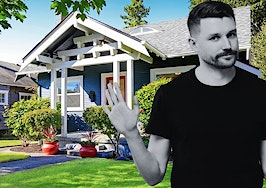At Inman Connect Las Vegas, July 30-Aug. 1, 2024, the noise and misinformation will be banished, all your big questions will be answered, and new business opportunities will be revealed. Join us.
Accessibility is one of the biggest challenges in American housing options. Couple that with business models that do not support accommodations in initial communication and onboarding, and the results are a less-than-great experience for the 85 million folks in America who live with physical, cognitive and mental disabilities.
This Fair Housing Month, let’s take a deep dive into some potential deficiencies your business may have serving this population, some education about the realities of what it is like to live with a disability, and tools and resources you can use to improve your customer service for this growing population, as senior Americans are fast becoming a significant sector.
In this article, we will discuss three common pitfalls and three easy improvements you can make to help align your team with ADA compliance and improve customer service.
Pitfall No. 1: There is no way for those with physical disabilities to tour your new listing
One of the most significant barriers for those with physical disabilities is finding a home that they can enter that has not been modified. This means that they are looking to have access to a home to see if it has the potential to be modified for their needs. They may use the scale of accessibility as a guide for how much would have to be done to the home to make it work for their lifestyle.
Researchers created an Accessibility Index, based on the data gathered for the 2011 American Housing Survey, which classified housing units into three levels of accessibility:
Level 1: Potentially modifiable
Homes in this category have some essential accessibility features but would not be fully accessible without further modifications, including the following:
-
- Stepless entry into the dwelling from the exterior
- A bathroom on the entry level or the presence of an elevator in the unit
- A bedroom on the entry level or the presence of an elevator in the unit
Level 2: Livable for individuals with moderate mobility difficulties
Homes in this category have a minimum level of accessibility that allows a person with moderate mobility difficulties to live in the home. Level 2 homes include all the features of Level 1 homes as well as additional features, including the following:
-
- No steps between rooms or rails/grab bars along all steps
- An accessible bathroom with grab bars
Level 3: Wheelchair accessible
Homes in this category have a minimum level of accessibility sufficient for a wheelchair user to live in the home and prepare his or her own meals. This group includes all the features in levels 1 and 2, and additional features, including the following:
-
- Extra-wide doors or hallways
- No steps between rooms
- Door handles instead of door knobs
- Sink handles or levers instead of knobs
- Wheelchair-accessible electrical switches, electrical outlets, and climate controls
- Wheelchair-accessible kitchen countertops, kitchen cabinets, and other kitchen features
How to improve it: Become familiar with the scale of accessibility of your new listing. If the home is accessible, highlight that in the listing description. This will help those searching for accessible housing recognize the potential the home could have for them.
Does the home need a mobile ramp for open houses and showings? Invest in a portable ramp so that everyone can access your listing as needed.
Just how hard is it for clients to find accessible housing? Check out this video interview, in which we share the facts about how the search for accessible housing is like searching for a needle in a haystack.
Pitfall No. 2: Your website is not friendly for those with low vision, cognition or auditory disabilities
Only about 3 percent of the internet is accessible to those with disabilities. Think about that. How often do you use the internet each day? Imagine how frustrating it would be to not be able to access the information you need because it is inaccessible because of an impairment that you may have.
“People with disabilities navigate the web in a variety of ways. People who are blind may use screen readers, which are devices that speak the text that appears on a screen. People who are deaf or hard of hearing may use captioning. People whose disabilities affect their ability to grasp and use a mouse may use voice recognition software to control their computers and other devices with verbal commands.” — ADA website compliance guidance
Can someone with low vision or no vision at all find a home on your website or contact you for more information? In July 2022, we updated an opinion article that was shared with us from the viewpoint of the struggle to find a home that you cannot see.
How to improve it: Structuring your website for these impairments requires strategic thought and planning. Design, audio and SEO components need to be considered. A website evaluation tool can highlight issues your site has and provide a list of recommended improvements.
Pitfall No. 3: Your office and parking aren’t accessible for clients to meet with you
Your posh boutique office in a 200-year-old building may not meet accessibility standards. This means that agents who want to work for you, and customers who want to work with you, may automatically dismiss your services because there are too many environmental challenges to come into the office.
Many real estate offices lack accessible parking, wide enough doorways, an alternative to stairs, conference rooms that can accommodate assistive devices and bathrooms with safety features.
In the past few years, universities have been asking their architecture students to use a wheelchair, wear blindfolds and use a cane to understand how design impacts the experience and accessibility of buildings for those with disabilities.
How to improve it: Conduct an experiment and see how easy your office is to navigate. If your office is based in the cloud and you don’t have a physical space, seek out accessible public meeting spaces. You can check how accessible a space is using Google Maps.
Bonus: Watch this video about things you can do in your office to make it more inclusive for team members and the public.
Wrapping Up
During Fair Housing Month, I see many educational efforts to help ensure that Realtors are providing a fair and equitable experience for all consumers seeking a home, but the above pitfalls are rarely discussed in general education. All businesses open to the public are required to meet ADA guidelines.
It is a rarity that I see real estate offices transcend all three of these pitfalls for their clients and their team members. Currently, 18 percent of the American population is 65 or older. Boomers and Generation Jones have deep pockets and significant equity in the real estate market. About 7 percent of Americans report some physical or mobility disability.
Don’t let your office, your team, or your website be a barrier to someone with disabilities. Accessible design benefits everyone, and advocating for it is your fiduciary responsibility.
“Part of the problem is that we tend to think that equality is about treating everyone the same, when it’s not. It’s about fairness. It’s about equity of access.” — Judith Heumann
Not everyone has the same tools in their toolbox, and what is fair for one person may not be fair at all for someone with disabilities. Adjust your perspective, and good business practice will follow suit.
Rachael Hite is a former agent, a business development specialist, fair housing advocate, copy editor and is currently perfecting her long game selling homes in a retirement community in Northern Virginia. You can connect with her about life, marketing and business on Instagram.













